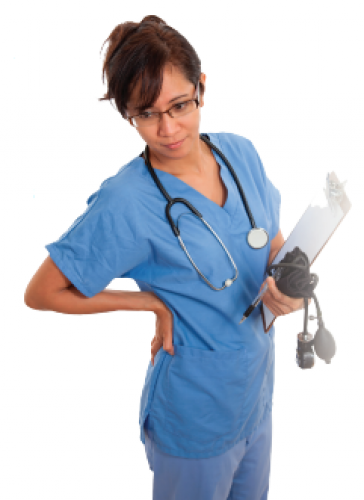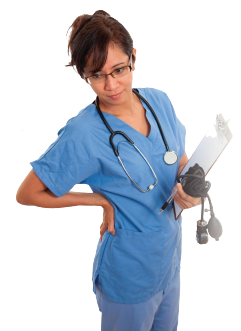Healthy Nurse, Healthy Nation™ Blog - The Importance Of Safe Patient Handling And Mobility For Nurses
Published
 Over the course of a year, 35,800 nurse workdays are lost due to musculoskeletal injury, according to the Bureau of Labor Statistics, and according to Healthy Nurse, Healthy Nation's HealthyNurse Survey, 31% of respondents felt they were at significant risk at their current employer for lifting/repositioning heavy objects, including patients.
Over the course of a year, 35,800 nurse workdays are lost due to musculoskeletal injury, according to the Bureau of Labor Statistics, and according to Healthy Nurse, Healthy Nation's HealthyNurse Survey, 31% of respondents felt they were at significant risk at their current employer for lifting/repositioning heavy objects, including patients.“Nurses are the heart of health care, yet they are the most injured profession. We have to protect our caregivers,” says Jeff Gorton, Senior Director of Sales at Sage Products.
Safe patient handling and mobility (SPHM) is such a critical issue to the nursing force, that the American Nurses Association has created the Safe Patient Handling and Mobility Interprofessional National Standards to guides nurses on this topic.
“Here’s an interesting way to think about the issue: Name any profession where workers are expected to lift 100 pounds on a daily basis. Even construction workers or UPS workers wouldn’t regularly lift that much. Yet, nurses often consider a 100 or 150-pound patient to be an easy load,” says Gorton.
What is Safe Patient Handling and Mobility?
SPHM is a series of practices and technology to prevent injury and protect nurse well-being in the workplace. Practices should begin the moment that the patient is picked up in an ambulance or enters the hospital and continue until the patient is released. View this helpful infographic: Understanding the benefits of a comprehensive SPHM program.
Small movements matter
Most injuries that nurses sustain on the job are not from one-time events, but from repetitive motions that they perform frequently. “Over time, a movement that seems to be a simple every day task can trigger a serious injury,” says Gorton.
For example, the seemingly simple act of boosting or repositioning a patient can put nurses at risk of musculoskeletal disorders such as:
- Low back pain
- Sciatica
- Rotator cuff injuries
- Epicondylitis (tennis elbow)
- Carpal tunnel syndrome
How technology can help
There are a variety of technological advances that can help nurses care for patients, while keeping themselves safe from injury, including:
- Powered cots
- Slider boards
- Slings
- Lifts
- Air-assisted technology to help position, move, and transfer from the bed to the stretcher, or vice versa.
A SPHM program should include these components:
- Benchmarks - It’s important to know where your hospital is currently, so you can track improvements.
- Ownership - Is there a person or group of people who will champion the program and keep others engaged?
- Tools - What equipment does the hospital already have on hand? What needs to be added?
- Process - Once the tools and equipment are available, is there a system in place so that nurses know how to access and use them?
Don’t have a SPHM program at your hospital yet?
Here’s what you can do:
- Make wise decisions on SPHM on an individual level. Ask colleagues for help, get a patient’s family involved, and take advantage of any tools available to you.
- Talk to members of your leadership team. In 10 years of working with hospitals on SPHM, Gorton says, “they all want to make improvements and increase the safety of their staff.”
- Consider joining or starting a committee that supports the SPHM program at your workplace.
- Visit the ANA SPHM website to access background information on SPHM and links to resources.
A SPHM program is crucial to the safety of the staff. As Gorton says, “We've become numb to the statistics. We have to remember that every number has a name and every name has a story.”
SPHM is just one piece of a nurse’s health and wellness. Join the Healthy Nurse, Healthy Nation™ (HNHN) Grand Challenge for tips, inspiration, and information on improving the health of nurses in five key areas: physical activity, rest, nutrition, quality of life, and safety.
What do you think about this article? Have you been injured in the workplace? Could it have been prevented? Share your stories with us in our Safety Challenge discussion or post your comments on Facebook, Twitter, or Instagram. Tag a nurse and us with #HealthyNurse.
Healthy Nurse, Healthy Nation™ was made possible in part by the generosity of the American Nurses Foundation and its sponsor Sage Products (a part of Stryker Medical). (Editor's note: This blog was originally posted in 2017).
 Have you joined the Healthy Nurse, Healthy Nation (HNHN) Grand Challenge yet? Join us today!
Have you joined the Healthy Nurse, Healthy Nation (HNHN) Grand Challenge yet? Join us today! Updated 12/1/22
Blog Safety
06/14/2017 10:14am CDT



Post a Comment or Question